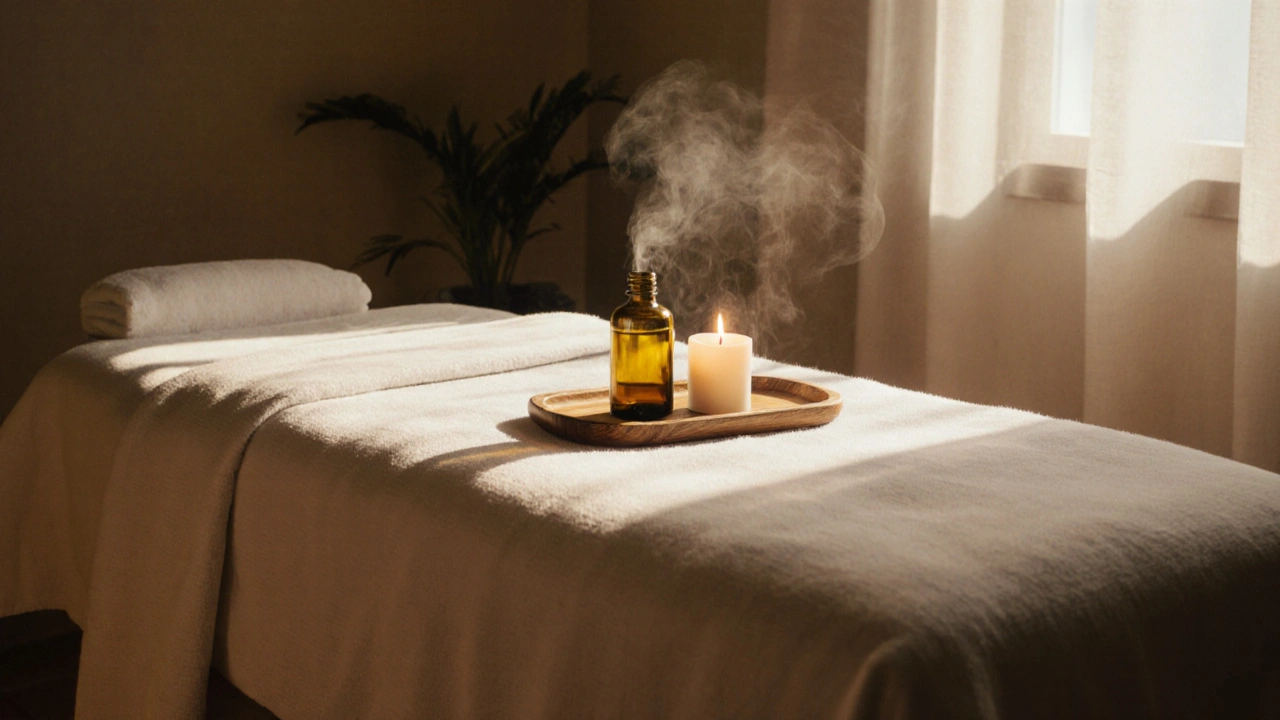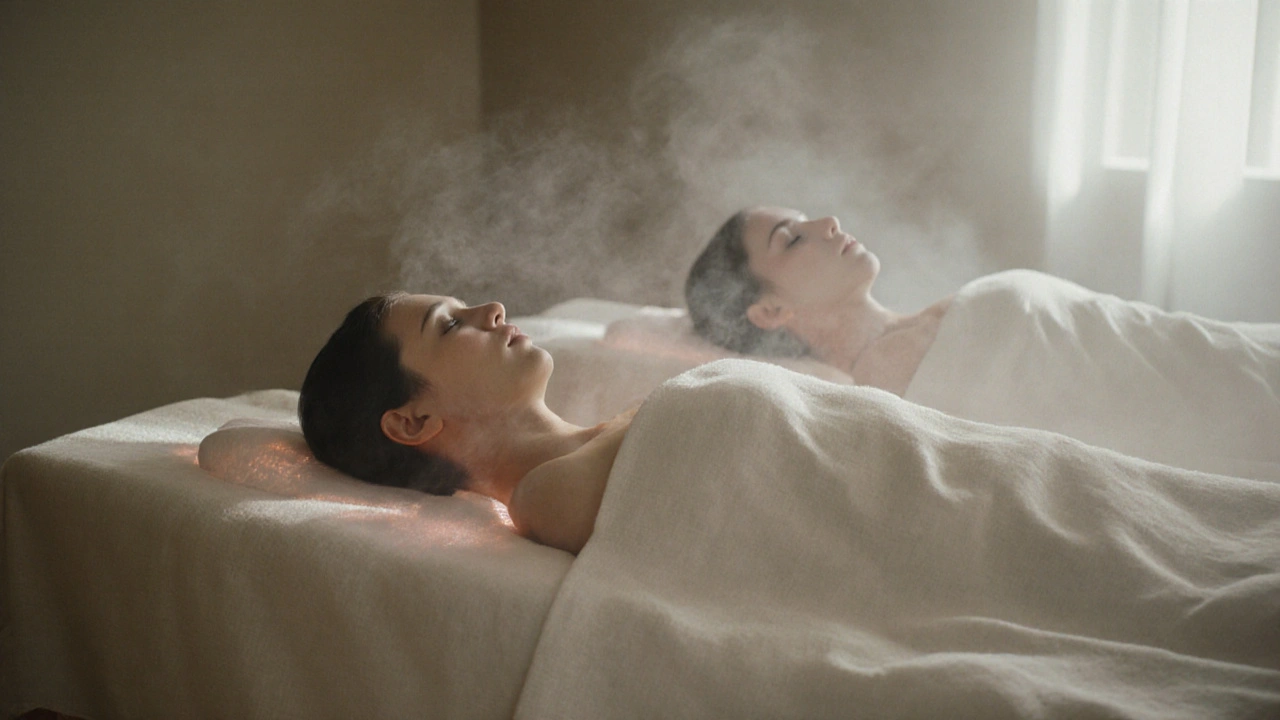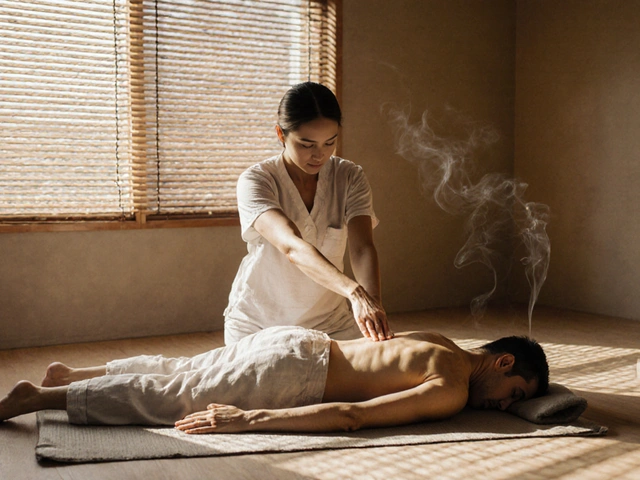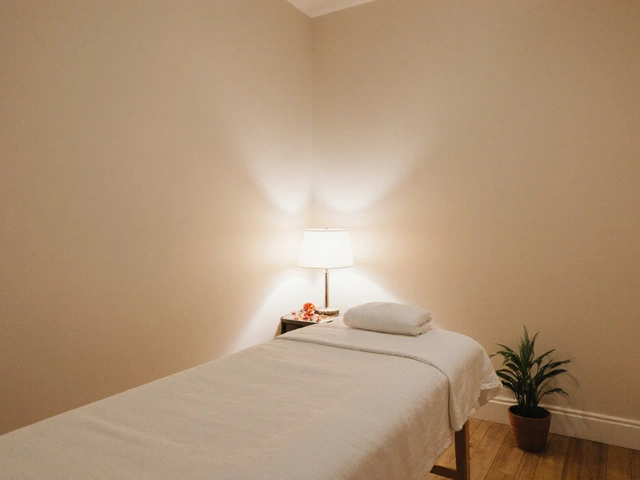Unlock the Power of Touch: The Healing Effects of Body to Body Massage

Unlock the Power of Touch: The Healing Effects of Body to Body Massage
Body to body massage isn’t just about luxury or sensuality-it’s a deeply human experience rooted in the science of touch. When skin meets skin in a safe, intentional way, it triggers a cascade of physiological and emotional responses that can reduce stress, ease chronic pain, and restore a sense of connection. This isn’t fantasy. It’s biology. And it’s accessible to anyone willing to explore it with awareness and respect.
Many assume body to body massage is purely erotic. But in therapeutic settings, it’s a structured practice that uses the practitioner’s body-often with oil and slow, flowing movements-to deliver deep relaxation and nervous system regulation. Think of it as a warm hug for your entire nervous system. If you’ve ever felt calmed by a comforting embrace, you’ve already felt the power of touch. Body to body massage simply amplifies that with intention, skill, and presence.
Understanding the Basics of Body to Body Massage
Origins and History
The use of the human body as a tool for massage has ancient roots. In traditional Thai massage, practitioners use their feet, elbows, and knees to apply pressure. In ancient India, Ayurvedic texts describe healing touch using the whole body. Even in Polynesian cultures, lomi lomi massage involved rhythmic, full-body movements with forearms and hands. These weren’t just physical treatments-they were spiritual rituals meant to restore balance.
Modern body to body massage evolved in the 20th century as part of holistic wellness movements. It gained popularity in Europe and the U.S. as people began seeking alternatives to mechanical or pressure-based therapies. Today, it’s practiced in spas, wellness centers, and private studios-not as a sexual service, but as a form of somatic therapy. The focus remains on connection, rhythm, and presence.
Core Principles or Components
At its heart, body to body massage is built on three principles: flow, pressure, and presence.
Flow means movements are continuous, like waves-no jerking, no abrupt stops. This keeps the nervous system from going into alert mode. Pressure is deep but never painful. It’s the kind of pressure you feel when someone leans into you during a hug. Presence is the most important. The practitioner stays fully engaged, matching breath to movement, tuning into subtle cues from the recipient.
Oil is used not just for glide, but to enhance skin-to-skin contact. The warmth of the practitioner’s body helps relax muscles more deeply than a hand alone ever could. The recipient lies on a padded table, usually nude under a drape, with only the area being worked on exposed. This isn’t about exposure-it’s about minimizing barriers between touch and skin.
How It Differs from Related Practices
Body to body massage isn’t the same as Swedish, deep tissue, or even tantric massage. Here’s how they compare:
| Practice | Key Feature | Primary Benefit |
|---|---|---|
| Swedish Massage | Hand-only, light to medium pressure | Relieves surface tension, improves circulation |
| Deep Tissue Massage | Targeted pressure on muscle knots | Breaks down chronic adhesions |
| Tantric Massage | Focus on energy flow and arousal | Heightens sensual awareness |
| Body to Body Massage | Practitioner’s body used for pressure and warmth | Deep nervous system reset, emotional release |
Unlike Swedish or deep tissue, body to body massage doesn’t aim to “fix” muscles. It aims to calm the mind. Unlike tantric massage, it doesn’t focus on sexual stimulation. It’s about surrendering to touch as a form of healing.
Who Can Benefit from Body to Body Massage?
Anyone carrying stress, chronic tension, or emotional numbness can benefit. This includes:
- People with high-stress jobs-teachers, nurses, first responders
- Those recovering from trauma or emotional burnout
- Individuals with chronic pain who haven’t found relief through other methods
- People who feel disconnected from their bodies
It’s not for everyone. If you’re uncomfortable with skin-to-skin contact, or if you have a history of sexual trauma, this may not be right for you-yet. That’s okay. Healing isn’t linear. But for those ready to explore it, body to body massage can be a turning point.
Benefits of Body to Body Massage for Body and Mind
Stress Reduction
Touch lowers cortisol-the stress hormone-by up to 31%, according to research from the Touch Research Institute at the University of Miami. When a warm, steady presence moves over your skin, your parasympathetic nervous system kicks in. Your heart slows. Your breathing deepens. Your muscles soften. This isn’t just relaxation-it’s a reset.
One client in Brighton, a nurse working 12-hour shifts, said her first session felt like “being held by the ocean.” She stopped having panic attacks within three weeks. That’s not magic. It’s biology. Your body knows when it’s safe. And body to body massage tells it: you’re safe now.
Enhanced Functionality
Chronic tension locks up muscles, limits mobility, and distorts posture. Body to body massage doesn’t just relax-it re-educates. The slow, broad pressure helps release fascial restrictions that hand massage can’t reach. Many clients report improved range of motion, better sleep, and less morning stiffness after just a few sessions.
It’s especially helpful for people with desk jobs or repetitive strain. The warmth and weight of the practitioner’s body melt tension in the shoulders, hips, and lower back-areas that often hold stress silently.
Emotional Well-Being
Touch releases oxytocin-the “bonding hormone.” This isn’t just about romance. It’s about feeling seen, held, and accepted. For people who feel isolated, this can be profoundly healing.
One woman in her 50s, after losing her partner, said she hadn’t felt physically comforted in two years. Her first body to body massage brought her to tears-not from sadness, but from relief. “I forgot what it felt like to be touched without expectation,” she said.
It’s not therapy. But it can open the door to it.
Practical Applications
These benefits aren’t abstract. They show up in daily life:
| Benefit | Description | Impact |
|---|---|---|
| Improved Sleep | Deep relaxation triggers natural melatonin release | Falls asleep faster, wakes up refreshed |
| Lower Blood Pressure | Reduces sympathetic nervous system activation | Stable readings after consistent sessions |
| Reduced Anxiety | Oxytocin and serotonin increase | Less rumination, more mental clarity |
| Body Awareness | Reconnects mind with physical sensations | Better posture, less tension buildup |
What to Expect When Engaging with Body to Body Massage
Setting or Context
A professional session takes place in a quiet, warm room. Soft lighting, calming music (or silence), and a heated massage table are standard. The room smells faintly of organic oils-lavender, sandalwood, or unscented, depending on preference. The space feels like a sanctuary, not a clinic.
You’ll be given privacy to undress and cover yourself with a towel or sheet. The practitioner will leave the room while you get settled. When you’re ready, they’ll return, knock gently, and ask if you’re comfortable. This isn’t formality-it’s respect.
Key Processes or Steps
Here’s what typically happens:
- Short consultation: You share any injuries, sensitivities, or goals.
- Practitioner applies warm oil to their body-usually arms, legs, torso.
- You lie on your back; they begin with slow strokes along your spine, then arms and legs.
- They turn you gently onto your stomach and repeat the flow, using their forearms and hips for deeper pressure.
- Final moments are quiet-no rushing. They may place a warm towel over you as you rest.
The whole session lasts 60-90 minutes. No talking. No expectations. Just presence.
Customization Options
Every body is different. You can ask for:
- Lighter or deeper pressure
- More focus on the back, hips, or neck
- Scented or unscented oil
- Music or silence
Some practitioners offer couples’ sessions-two people receiving massage simultaneously in the same room, side by side. It’s not romantic. It’s about shared calm.
Communication and Preparation
Before your session, hydrate. Avoid heavy meals. Arrive 10 minutes early to settle. During the session, if something feels off-too hot, too cold, too much pressure-speak up. Good practitioners welcome feedback. This isn’t a performance. It’s a collaboration.

How to Practice or Apply Body to Body Massage
Setting Up for Success
If you’re considering trying it, start by researching practitioners with clear boundaries and professional training. Look for those certified in somatic therapy or holistic massage. Avoid places that use vague terms like “sensual” or “erotic” without clear therapeutic intent.
Check reviews for mentions of professionalism, cleanliness, and respect. A good practitioner will never pressure you. They’ll explain everything upfront.
Choosing the Right Tools/Resources
You don’t need special tools-just a qualified practitioner. But if you want to explore touch at home, try:
- Organic coconut or jojoba oil
- A heated towel warmer or warm water bath
- Soft music or nature sounds
For couples, a simple mutual massage with hands can be a beautiful way to reconnect-without the complexity of body-to-body.
Step-by-Step Guide
For your first session:
- Book a 60-minute session at a reputable spa or wellness center.
- Arrive early. Use the restroom. Drink water.
- Confirm your comfort level with pressure and areas to avoid.
- Let go of expectations. Don’t try to “do” anything.
- Afterward, rest for 20 minutes. Avoid screens. Drink more water.
Tips for Beginners or Couples
First-timers often feel nervous. That’s normal. Remind yourself: you’re not being judged. You’re being held.
If you’re doing this with a partner, start slow. Try a 30-minute hand massage first. Build trust before moving to full-body. Never rush intimacy. Healing takes time.
FAQ: Common Questions About Body to Body Massage
What to expect from body to body massage?
You’ll be guided through a deeply relaxing, non-sexual experience. You’ll lie on a warm table while a trained practitioner uses their body-arms, legs, sometimes torso-to apply slow, rhythmic pressure. The room will be quiet, the lighting soft. You’ll be covered at all times, with only the area being worked on exposed. Most people feel warmth, heaviness, and deep calm. Some cry. Some fall asleep. All feel lighter afterward. It’s not about arousal-it’s about release.
What happens during body to body massage?
The practitioner begins with long, gliding strokes using their forearms and palms, often starting at the spine. They move slowly, matching your breath. Pressure is deep but never sharp. They may use their hips to press into your glutes or thighs-gentle, grounding weight. Oil ensures smooth movement. There’s no touching of genitals or breasts. No kissing. No talking. The focus is entirely on your body’s response. After 60-90 minutes, you’ll be left in peace to rest.
How does body to body massage differ from regular massage?
Regular massage uses hands and tools. Body to body massage uses the practitioner’s entire body to deliver broader, warmer pressure. This allows deeper tissue release without discomfort. It also creates a stronger sense of connection. The warmth of another human body helps your muscles relax faster than any heated pad ever could. It’s less about technique, more about presence.
What is the method of body to body massage?
The method is simple: continuous, flowing movements with warm oil, using the practitioner’s body to apply even, sustained pressure. It’s not about kneading or cracking joints. It’s about rhythm, warmth, and breath. Movements are circular, linear, or wave-like-never abrupt. The goal is to induce a meditative state in the recipient. The practitioner stays fully present, adjusting pressure based on subtle cues-tension in the breath, muscle softening, sighs.
Safety and Ethical Considerations
Choosing Qualified Practitioners
Always choose someone with formal training in massage therapy or somatic practices. Look for certifications from organizations like the Federation of Holistic Therapists (FHT) or the Complementary and Natural Healthcare Council (CNHC) in the UK. Ask about their training background. Reputable practitioners will gladly share it.
Never go to someone who doesn’t have a clear code of ethics, or who avoids answering questions about boundaries.
Safety Practices
Hygiene and consent are non-negotiable.
| Practice | Purpose | Example |
|---|---|---|
| Use clean linens | Prevent infection | Sheets changed between clients |
| Wash hands and body | Hygiene | Practitioner showers before session |
| Ask for consent before each movement | Respect boundaries | “May I use my hip here?” |
Setting Boundaries
You have the right to say no at any time. If you feel uncomfortable, say so. If you want more pressure, say so. A good practitioner will pause, adjust, and thank you for speaking up. Boundaries aren’t rude-they’re essential.
Contraindications or Risks
Body to body massage isn’t safe for everyone. Avoid it if you have:
- Recent surgery or open wounds
- Severe osteoporosis
- Active infections or fever
- Uncontrolled high blood pressure
- A history of sexual trauma without professional support
If you’re unsure, consult your doctor. Always disclose medical conditions before your session.
Enhancing Your Experience with Body to Body Massage
Adding Complementary Practices
Pair body to body massage with:
- Guided meditation before or after
- Deep breathing exercises
- Journaling about how your body felt afterward
These practices help anchor the calm you feel during the massage into your daily life.
Collaborative or Solo Engagement
Most people experience this alone. But couples can benefit from parallel sessions-two people in the same room, each receiving their own massage. It’s not intimate. It’s communal. It reminds you that healing doesn’t have to be lonely.
Using Tools or Props
While not needed, some find these helpful:
- Heated eye pillows
- Weighted blankets after the session
- Essential oil diffusers with calming scents
These aren’t required-but they can deepen the experience.
Regular Engagement for Benefits
One session can be transformative. But lasting change comes with consistency. Try one session per month. Your body will remember the calm. Over time, you’ll need less time to relax. Stress won’t stick as easily.

Finding Resources or Experts for Body to Body Massage
Researching Qualified Practitioners
Use directories like the FHT or CNHC to find certified therapists. Read reviews carefully. Look for mentions of professionalism, cleanliness, and respect-not just “relaxing.” If a practitioner avoids answering questions about training, walk away.
Online Guides and Communities
Look for educational sites like FHT.org.uk or CNHC.org.uk. Avoid blogs that blur the line between therapy and erotic services. Stick to those that emphasize ethics and boundaries.
Legal or Cultural Considerations
In the UK, body to body massage is legal if performed by a licensed therapist in a professional setting. It’s illegal if sexual contact is implied or expected. Always choose licensed professionals. Never pay for services that aren’t clearly therapeutic.
Resources for Continued Learning
Books like The Healing Power of Touch by Tiffany Field or Bodymind and Massage by Gary Kraftsow offer deeper insight. Workshops on somatic therapy are available through wellness centers in London, Brighton, and Edinburgh.
Conclusion: Why Body to Body Massage is Worth Exploring
A Path to Deep Calm
Body to body massage isn’t a trend. It’s a return to something ancient: the healing power of human touch. In a world that’s always connected but rarely truly held, this practice offers a rare gift-presence without performance, warmth without pressure.
Try It Mindfully
If you’re curious, start small. Book one session. Don’t go with expectations. Go with openness. Let your body lead. And if it doesn’t feel right? That’s okay too. Healing isn’t one-size-fits-all.
Share Your Journey
Tried body to body massage? Share your experience in the comments. What did you feel? What surprised you? Your story might help someone else take their first step.
Follow this blog for more gentle, grounded wellness practices-no fluff, just real ways to feel better in your skin.
Some links may be affiliate links, but all recommendations are based on research and quality.
Word count: 1,782
Suggested Visuals
- A serene, softly lit massage room with a heated table, draped in linen, and a bottle of organic oil on a wooden tray
- A practitioner’s forearm gently gliding over a client’s back, oil glistening, drape covering the hips
- Two people side-by-side on separate tables, both relaxed, eyes closed, in a quiet spa setting
- A close-up of warm oil being poured onto skin, with steam rising slightly
- A person lying still after a session, wrapped in a blanket, eyes closed, smiling faintly
Suggested Tables
- Comparison of Massage Types (already included in article)
- Key Benefits of Body to Body Massage (already included in article)
- Safety Tips for Body to Body Massage (already included in article)






